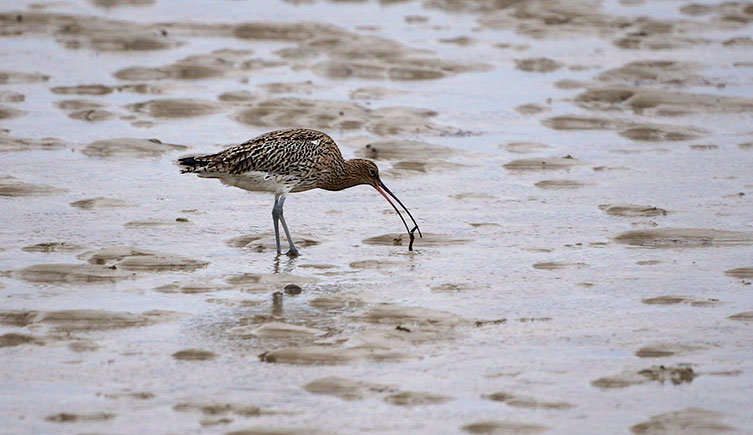Squiggly little mounds of sand are a common sight when you walk along a beach at low tide. These are the signs of a hidden but industrious worm that has an important place in the beach ecosystem.
What's more, a quick look at those sand piles will help you decode a secret that they kept from scientists for rather a long time.
The sandy mounds are worm casts, effectively the poo, of a marine worm called a lugworm. Common on sandy and muddy-sandy shores around the coast of Britain, they live in burrows under the wet sand.
Lugworm lifestyle
A lugworm spends most of its life in the safety of its burrow, which is U- or J-shaped. It lies with its head at the bottom of the tunnel and its tail pointing up towards the surface.
For much of the day their burrows are under the sea, but at low tide they are exposed.
The worm feeds on micro-organisms and organic matter in the water and sandy sediment collected in the front end of its burrow. Indigestible material passes through the worm and is ejected from the back of the burrow via its tail. This worm poo forms the distinctive casts on the surface.
Two species of lugworms
At a casual glance, one worm cast looks much like another. But if you take a closer look, on some beaches you might notice two distinct types. Some casts are messy, like squiggly spaghetti, while others form a neater spiral.
The two types of cast are an indication that there are two common lugworms living on Britain's shores.
The blow lugworm (Arenicola marina) produces the messier cast. They grow up to about 20cm in length and vary in colour, from pink or greenish to dark brown or black. Their burrows are between 20-40cm below the surface.
As well as the tell-tale cast, you can also usually spot a slight depression close by in the sand which marks the front entrance to its burrow.
The black lugworm (Arenicola defodiens) produces the neater spiral cast. It is usually longer - up to 40cm or more - and darker in colour than the blow lugworm. Its burrow is deeper, between 40-70cm below the surface, and normally lacks the depression in the sand marking a front entrance.
Blow lugworm can be found higher up the beach and are easier to find, whereas black lugworm live further down the beach. You might only spot their neat casts when the tide goes out a long way.
Fisherman, who dig up lugworms for fishing bait, have long known of the differences between the two. They particularly prize the black lugworm, though it is much harder to extract from its deep burrow.
However, the black lugworm wasn't officially identified as a separate species from the blow lugworm until 1993, when researchers at Swansea University detailed their genetic differences.
A vital part of the shoreline ecosystem
Like their relatives, the earthworms, lugworms play an important role in their local ecosystem.
The lugworms' burrowing and feeding helps to aerate the sand and release nutrients back into the ground, helping other organisms to thrive.
Lugworms also have an important place in the foodweb. As well as digesting small organisms and helping to break down decaying matter, they are eaten by other animals.
Although lugworms, deep in their burrows, are fairly well protected, they are vulnerable when they expel waste from their bodies. To do so, they must bring their tail near to the surface to produce the sand cast. This is the point at which predators can attack.
If the burrow is underwater at the time, then fish and crabs will take a bite at the tail. When the burrow is exposed at low tide, birds such as curlews and godwits will swoop on them.
Fortunately for the lugworm, it has a fragile tail that can break off from the rest of it body if attacked. So often the predator ends up with a tasty morsel, but the lugworm survives.
Even so, quite a few lugworms do end up completely eaten and they are estimated to be an important food resource for many birds.
The lugworm lifecycle
The lifecycle of these animals has been well studied and they can live for around five to six years.
When it comes to lugworm love, reproduction is done at a distance. Male and female lugworms live in different burrows and don't come out to mate. So, once a year in the autumn, when the tide is out, males release sperm on to the sand's surface. When the tide comes back in, the sea water washes the sperm into the burrows of the females and their waiting eggs.
The juvenile lugworms spend the winter in quiet channels, then in the spring they build burrows close together high up on the beach, known as nursery beds. Towards the end of that year, they float down the beach on the tide and make new burrows. By the second year they will be fully grown adults and ready to begin the cycle again.
So the next time you squish a cast under your toes at the beach, think of the secret world underneath your feet and the busy life of a lugworm.










Don't miss a thing
Receive email updates about our news, science, exhibitions, events, products, services and fundraising activities. We may occasionally include third-party content from our corporate partners and other museums. We will not share your personal details with these third parties. You must be over the age of 13. Privacy notice.
Follow us on social media